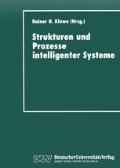Zusammenfassung
Wir gehen in dieser Arbeit von der Hypothese aus, daß die Augenbewegungsforschung eine Möglichkeit darstellt, Aufschlüsse über die Organisation kognitiver Strukturen und die Dynamik kognitiver Prozesse zu erhalten. Die Fruchtbarkeit dieser Hypothese zeigen wir anhand der Beschreibung einer Reihe von Experimenten und Studien, die in Projekten des SFB 360 der Universität Bielefeld, „Situierte Künstliche Kommunikatoren“, durchgeführt wurden. Einleitend werden die verwendete Eyetracker-Technologie und die praktizierten Methoden der Aufbereitung von Augenbewegungsdaten, Clusteranalyse und attentional landscapes, beschrieben.
In die nachfolgende Arbeit wurden zwei Vorträge integriert, die auf der 2. Fachtagung der Gesellschaft für Kognitionswissenschaft an der Universität Hamburg 1996 zum Thema „Kognition und Augenbewegungsforschung“ von den Autoren gehalten wurden, „Fokus als kognitionswissenschaftlicher Gegenstand“ und „Übertragung von Blickbewegungen und Kooperationsexperimente“. Für die Mitarbeit an denbeschriebenen Experimenten möchten wir uns bei Thomas Clermont, Peter Munsche, Gert Rickheit, Lorenz Sichelschmidt und Karin Wagner bedanken.
Access this chapter
Tax calculation will be finalised at checkout
Purchases are for personal use only
Preview
Unable to display preview. Download preview PDF.
Literatur
Bosch, P., & van der Sandt, R. (eds.) (1994). Focus and natural language Processing, 3 Vols. IBM Institute for Logic and Linguistics, Heidelberg.
Buswell, G.T. (1920). An experimental study of the eye-voice span in reading. Supplementary Educational Monographs, 17, 2–43.
Clark, H.H., & Marshall, C.R. (1981). Definite reference and mutual knowledge. In A.K. Joshi et al. (eds.), Elements of Discourse Understanding. CUP, Cambridge, 11–63.
Clark, H.H., & Wilkes-Gibbs, D. (1990). Referring as a collaborative process. In Cohen, P.R., Morgan, J., & Pollak, M.E. (eds.) (1990). Intentions in communication, MIT Press, Cambridge MA, 463–493.
Clark, H.H., & Wilkes-Gibbs, D. (1992). Coordinating beliefs in conversation. Journal of Memory and Learning, 31: 183–194.
Clermont, T., Meier, C., Pomplun, M., Prestin, E., Rieser, H., Ritter, H., & Velichkovsky, B.M. (1995). Augenbewegung, Fokus und Referenz.REPORT 95/8 DES SFB 360 „Situierte Künstliche Kommunikatoren“. Bielefeld: Universität Bielefeld.
Cohen, P.R. (1984). The pragmatics of referring and the modality of communication. Computational Linguistics, 10: 97–146.
Cohen, P.R., Morgan, J., & Pollak, M.E. (eds.) (1990). Intentions in communication, MIT Press, Cambridge MA.
Donnellan, K. (1966). Reference and definite descriptions. The Philosophical Review, 75, 281–304.
Günther, U., Laubenstein, U., & Sichelschmidt, L. (1987). „also ich lege ihn praktisch hin“-Beschreibung von Blockwelten. In Forschergruppe Kohärenz (ed.) „n Gebilde oder was“-Daten zum Diskurs über Modellwelten, KoLiBri Arbeitsbericht Nr. 2, Univerisität Bielefeld.
Hallett, P.E. (1986). Eye-movements. In Boff, K.R., Kauffman, L., Thomas, J.P. (eds.), Handbook of perception and performance. Vol. 1, New York: John Wiley and Sons.
Heydrich, W., & Rieser, H. (1995). Public Information and Mutual Error. Report 95/12 des SFB 360 „Situierte Künstliche Kommunikatoren“. Bielefeld: Universität Bielefeld.
Lüer, G. (1991). Does thinking aloud influence the structure of cognitive processes? In Schmid, R., Zambarieri, D. (eds.), Oculomotor control and cognitive processes. Normal and pathological aspects. North Holland.
Perrault, C.R. (1990). An application of default logic to speech act theory. In Cohen, P.R. et al. (eds.), Intentions in communication. MIT Press, Cambridge MA, 161–185.
Pomplun, M. (1994). Aufmerksamkeitsverteilungen in ambigen Bildern und ein vielseitiges Programmpaket für Eyetracking-Experimente. Diplomarbeit, Technische Fakultät der Universität Bielefeld.
Pomplun, M., Velichkovsky, B.M., & Ritter, H. (1994). An artificial neural network for high precision eye movement tracking. In Nebel, B., & Dreschler-Fischer, L. (eds.), Lecture notes in artificial intelligence. Berlin: Springer.
Pomplun, M.L., Sichelschmidt, L., Wagner, K., Velichkovsky, B.M., Rickheit, G., & Ritter, H. (1995). Visuelle Suchprozesse beim Vergleich zweidimensionaler Objektmengen. Teil 1: Zur Rolle der lokalen Verteilungsparameter. REPORT 95/9 DES SFB 360 „Situierte Künstliche Kommunikatoren“. Bielefeld: Universität Bielefeld.
Pomplun, M., Ritter, H., & Velichkovsky, B.M. (1996). Disambiguating complex visual information: Towards communication of personal views of a scene. Perception, 25(8), 931–948.
Rieser, H. (1994). The role of focus in task oriented dialogue. In Bosch, P., & and van der Sandt, R. (eds.), Vol. 3: Discourse, 601-611.
Rieser, H., & Meier, C. (1995). Modelling situated agents’ „reference shifts“ in task-oriented dialogue, Technical Report of the SFB 360, Bielefeld University.
Schegloff, E.A. et al (1977). The preference for self-correction in the organization of repair in conversation. In Language, 2, 361–382.
Sedivy, J.C., Carlson G.N., Tanenhaus, M.K., Spivey-Knowlton, M., & Eberhard, K. (1994). The Cognitive Function of Contrast Sets in Processing Focus Constructions. In Bosch, P., & van der Sandt, R. (eds.), Vol. 3: Discourse, 611-619.
Stampe, D.M. (1993). Heuristic filtering and reliable calibration methods for video-based pupiltracking systems. Behavioral Research Methods, Instruments, and Computers, 25(2), 137–142.
Strohner, H., Sichelschmidt, L., & Duwe, I. (1994). Focus in resolving ambiguous reference. In Bosch, P., & van der Sandt, R. (eds.), Vol. 3: Discourse, 629-639.
Tomasello, M. (1995). Joint attention as social cognition. In Moore, C., & Dunham, P. (eds.), Joint attention: Its origins and role in development. Hillsdale, NJ: Lawrence Erlbaum.
Velichkovsky, B.M. (1995). Communicating attention: Gaze position transfer in cooperative problem solving. Pragmatics and Cognition, 3, 199–222.
Velichkovsky, B.M., Challis, B.H., Pomplun, M. (1995). Arbeitsgedächtnis und Arbeit mit dem Gedächtnis: Visuell-räumliche und weitere Komponenten der Verarbeitung. Zeitschrift für Experimentelle Psychologie, 4, 672–701.
Velichkovsky, B.M., Pomplun, M., & Rieser, H. (1996). Attention and communication: Eye-movement-based research paradigms, in Zangemeister, W.H., Stiehl, H.S. and Freksa, C. (eds.), Visual Attention and Cognition, Amsterdam: Elsevier.
Vygotsky, L.S. (1962). Thought and language (1st Russian edition, 1935). Cambridge, MA: MIT Press.
Wachsmuth, I., & Jung, B. (1996). Dynamical conceptualization in a mechanical-object assembly environment. Artificial Intelligence Review, 10,(3–4), 345–368.
Walter, J., & Ritter, H. (1996). Rapid learning with parametrized self-organizing maps. Neurocomputing, 12, 131–153.
Westheimer, G. (1976). Oculomotor Control: The Vergence System. Monty, R.A., Senders, J.W. (eds.), Eye Movements and Psychological Processes. New York: John Wiley and Sons.
Editor information
Editors and Affiliations
Rights and permissions
Copyright information
© 1997 Deutscher Universitäts-Verlag GmbH, Wiesbaden
About this chapter
Cite this chapter
Pomplun, M., Rieser, H., Ritter, H., Velichkovsky, B.M. (1997). Augenbewegungen als kognitionswissenschaftlicher Forschungsgegenstand. In: Kluwe, R.H. (eds) Strukturen und Prozesse intelligenter Systeme. Studien zur Kognitionswissenschaft. Deutscher Universitätsverlag, Wiesbaden. https://doi.org/10.1007/978-3-322-95358-2_4
Download citation
DOI: https://doi.org/10.1007/978-3-322-95358-2_4
Publisher Name: Deutscher Universitätsverlag, Wiesbaden
Print ISBN: 978-3-8244-4229-4
Online ISBN: 978-3-322-95358-2
eBook Packages: Springer Book Archive

